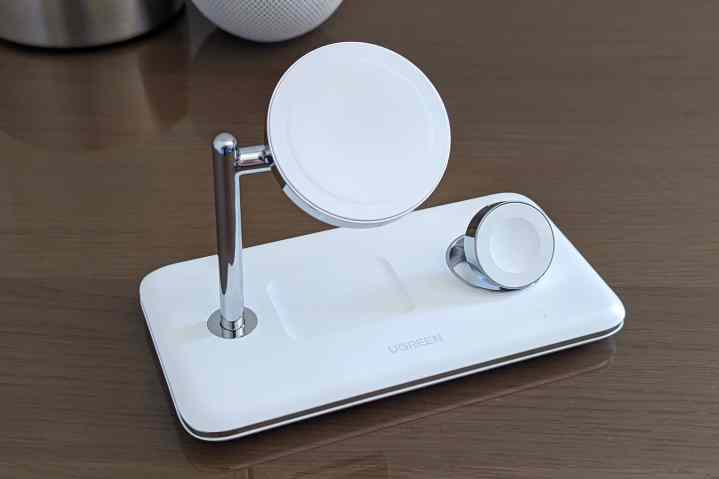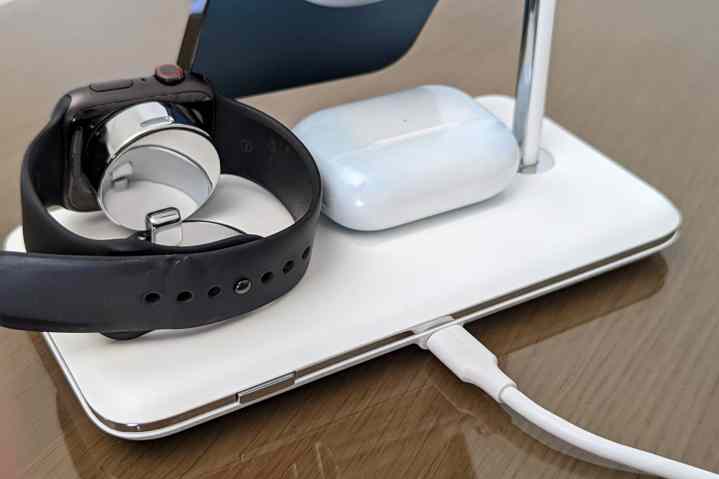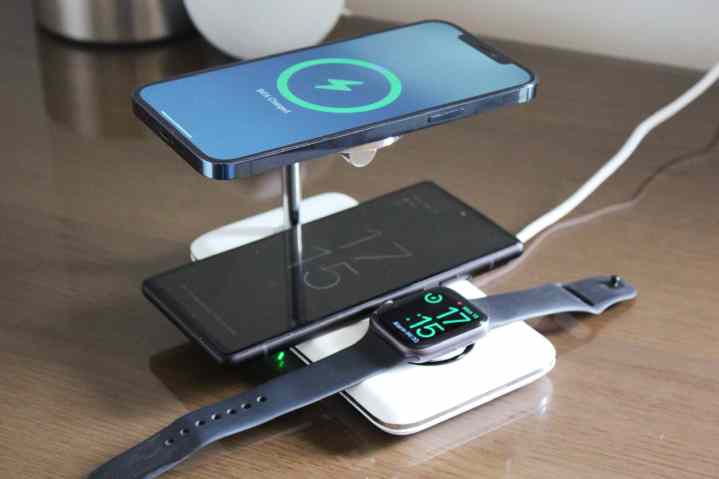Many iPhone owners these days have more than just their smartphone to charge up at night. because of Apple’s robust product ecosystem, an iPhone is often joined by an Apple Watch and a set of AirPods, and there’s no shortage of accessories designed to make it easy to manage and charge these devices together.
Such is the case with the $130 Ugreen 3-in-1 MagSafe Charging Station, which takes advantage of the MagSafe technology built into iPhone 12 and newer models. Ugreen’s charging station holds your phone in place while fast charging it and juices up your Apple Watch and a set of AirPods (or other small wireless charge-capable earphones) at the same time. It’s an impressive-sounding package on paper. But what’s it like to use?
MagSafe vs. magnetic charging

Although the iPhone has supported wireless charging since the 2017 iPhone 8 and iPhone X were released, this was typically limited to a maximum of 7.5-watt charging. That fell short of what many competing Android handsets were offering. It wasn’t until the iPhone 12 came along two years ago that Apple increased wireless charging speeds. Still, like many other manufacturers, the company chose to do so by introducing its own proprietary charging standard: MagSafe.
As the name suggests, the most visible feature of MagSafe is the magnetic attachment between an iPhone and a charger. However, there’s a more important aspect that’s not quite as apparent unless you pay close attention. Anybody can make a wireless charger with a ring of magnets that will match up with those found on a modern iPhone, but only an Apple-certified MagSafe charger will provide 15W charging.
While we can’t currently say for sure what the iPhone 14 will bring, the iPhone 13 still charges at only 7.5W when laid onto a standard Qi-compatible wireless charger. Only genuine MagSafe chargers will provide the fastest wireless charging that modern iPhones are capable of.
This can make it tricky to shop for wireless chargers, as many companies list their chargers as “magnetic” or even “MagSafe-compatible.” However, unless they carry Apple’s “Made for MagSafe” branding, they don’t offer 15W iPhone charging. Even well-known Apple accessory partners like Belkin and Mophie sell both MagSafe chargers and generic magnetic chargers that are also iPhone-compatible.
The good news is that Ugreen’s MagSafe charger fits into the former category. It’s officially MagSafe-certified by Apple, adding another solid option that folks with an iPhone and Apple Watch may want to consider.
A practical, flexible design

Ugreen’s 3-in-1 MagSafe charging station is one of the more compact tabletop stations we’ve seen. While it obviously can’t compete with a portable travel charger like Mophie’s 3-in-1, it takes up less space than Belkin’s 3-in-1 wireless dock.
It’s clear that Ugreen is going for a more practical than artistic design here, although that’s not to say the Ugreen stand is unattractive. It has a classy white soft plastic finish with chrome accents, but it still feels more utilitarian than stylish. The design may have been partly inspired by Apple’s MagSafe Duo travel charger, although the plastic on Ugreen’s stand isn’t quite as rubbery as what Apple uses.
To reduce the charging station’s footprint, Ugreen has tucked the AirPods charging pad behind the iPhone dock, a clever trick that makes use of what often ends up being dead space on other charging stands. This assumes that you don’t want to see your AirPods while they’re charging, but I think that’s fair, especially since there’s a green LED on the front of the stand that lights up when the AirPods charging pad is active.
The AirPods charging pad has a recess designed for an AirPods Pro case, but it’s just a 5W Qi-compatible charger, so you can use it for other earbuds that support wireless charging or any other small device thatcould fit in there. You can even drop another iPhone or Android phone on that spot, although it’s a bit awkward as it sits directly below the primary MagSafe charger.

It’s not impossible, though, as the MagSafe charging disc also pivots from about a 75-degree angle to a completely horizontal position. This lets you choose a convenient viewing angle for your iPhone and also means you can angle it upward to make room to charge another device below it. You can even lay out two phones bunk-bed style to charge both simultaneously.
The ability to orient the MagSafe charging disc to the horizontal also lets you easily charge other smartphones or even older iPhones that don’t support MagSafe — albeit only at slower 7.5W Qi charging speeds.
An Apple Watch can also be charged in one of two positions: laid face-up on the base with the strap extended or propped up in the traditional “nightstand mode” orientation. The Apple Watch charging disc is on a spring-loaded hinge that pops out from its recessed position in the charging base by pressing a button on the back. When extended, the disc can be adjusted to a 45-degree or 90-degree angle perpendicular to the base.
Although the Apple Watch charging disc folds down into the base, this is for charging, not portability. The MagSafe stand for the iPhone doesn’t fold down or detach, so this isn’t a stand you should expect to take with you. It’s designed to be left on a desktop or table.
Power and accessories
Ugreen’s 3-in-1 MagSafe stand requires a USB-C power source that can supply a minimum of 25W, and you’ll need to provide one as you’ll only find a USB-C cable in the box. That’s a bit disappointing considering the price of this stand, but Ugreen also sells a broad range of power adapters.
While you can use your Apple USB-C iPhone charger if you have one on hand, that only provides 20W of power, so you won’t be able to use all three charging areas at maximum performance. The stand requires 15W for the MagSafe charger, plus 5W each for the Apple Watch disc and AirPods pad.
It’s also worth mentioning that Ugreen’s stand can’t fast-charge an Apple Watch Series 7. It only provides 5W charging on the Apple Watch disc regardless of the model. That’s not surprising, though, as Belkin is the only third-party accessory maker that’s embraced faster charging for Apple’s latest wearable.
A good (albeit familiar) charging option

Ugreen’s 3-in-1 MagSafe charging stand is a capable charging stand that works as designed and offers a couple of interesting twists — particularly by being more adjustable than others we’ve looked at. However, there’s not much to set it apart other than the overall design.
To be clear, the adjustable stands are a big plus — I’ve been using Belkin’s Boost Charge Pro 3-in-1 wireless charging stand on my bedside table for the past couple of years, and there are times I’ve wished I could angle my iPhone into a more convenient position.
But if adjustability isn’t your thing, then you’re pretty much down to aesthetics. Ugreen is slightly more affordable than Belkin’s 3-in-1 MagSafe stand, its main rival. Still, it’s essential to keep in mind that Belkin includes the necessary charger, so you’ll only be saving money with Ugreen’s charging station if you already have a compatible 25W or greater USB-C charger on hand.
Editors' Recommendations
- Nomad’s new iPhone case and Apple Watch band may be its coolest yet
- iPhone 16: news, rumored price, release date, and more
- iPhone SE 4: news, rumored price, release date, and more
- Here’s how Apple could change your iPhone forever
- There’s a big problem with the iPhone’s Photos app




